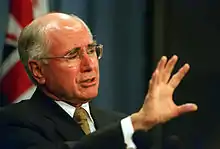| Wollstonecraft Sydney, New South Wales | |||||||||||||||
|---|---|---|---|---|---|---|---|---|---|---|---|---|---|---|---|
 Brennan Park | |||||||||||||||
 Wollstonecraft | |||||||||||||||
| Coordinates | 33°50′01″S 151°11′29″E / 33.83356°S 151.19128°E | ||||||||||||||
| Population | 8,323 (2016 census)[1] | ||||||||||||||
| • Density | 6,940/km2 (18,000/sq mi) | ||||||||||||||
| Postcode(s) | 2065 | ||||||||||||||
| Elevation | 61 m (200 ft) | ||||||||||||||
| Area | 1.2 km2 (0.5 sq mi) | ||||||||||||||
| Location | 4 km (2 mi) north of Sydney CBD | ||||||||||||||
| LGA(s) | North Sydney Council | ||||||||||||||
| State electorate(s) | North Shore | ||||||||||||||
| Federal division(s) | North Sydney | ||||||||||||||
| |||||||||||||||
Wollstonecraft (UK: /ˈwʊlstənkrɑːft/, US: /-kræft/) is a harbourside suburb on the lower North Shore of Sydney, New South Wales, Australia, 4 kilometres north of the Sydney central business district, in the local government area of North Sydney Council.
History
Wollstonecraft was named after Edward Wollstonecraft, the first settler to receive a land grant of 500 acres (200 hectares) in the area, in 1821.[2] Wollstonecraft left England to seek fortune for himself and his sister Elizabeth and to escape the notoriety of his aunt, Mary Wollstonecraft, author of the book A Vindication of the Rights of Woman.[3]
Edward Wollstonecraft's business associate, Alexander Berry, was another prominent resident in the area,[4] and namesake of Berry Island, a harbour-side location in Wollstonecraft.
The suburb is rich in its architectural history with a mixture of stately Victorian and Federation houses.
The area is part of the traditional lands of the Cammeraygal people of the Eora nation.
As of 2019 Wollstonecraft is ranked as the 6th most liveable suburb in Sydney out of the 569 on Domain.[5]
Population
In the 2016 Census, there were 8,323 people in Wollstonecraft. 55.7% of people were born in Australia. The next most common countries of birth were England 6.3%, China 3.9%, New Zealand 2.7%, Hong Kong 2.0% and India 1.9%. 69.3% of people spoke only English at home. Other languages spoken at home included Mandarin 4.1%, Cantonese 3.9%, Spanish 1.7% and Japanese 1.5%. The most common responses for religion were No Religion 39.2%, Catholic 21.3%, and Anglican 11.3%.[1]
| 1991 | 1996 | 2001 | 2006 | 2011 | 2016 |
| 5696 | 6355 | 7572 | 7580 | 8012 | 8323 |
Natural Reserves and Parks
- Badangi Reserve – Badangi Reserve is a small protected reserve with one main path connecting adjacent Berry Island and Wondakiah up to Bridge End road near the trainline
- Berry Island – The most well known park in the suburb which has a large open grass strip next to the harbour and a loop bush track with a lookout overlooking the inner harbour as well as Indigenous rock engravings further along the trail.
- Gore Cove Reserve – Long waterside bush trail up Berry's creek from Berry Island up to Smoothey park and Wollstonecraft railway station.
- Brennan Park – Popular park next to Waverton and the train line with a large playground and open space.
- Smoothey Park
- Oyster Cove Reserve
- Harry Howard Reserve
 Brennan Park
Brennan Park View over Brennan Park
View over Brennan Park
Transport
Wollstonecraft railway station is on the North Shore railway line.
Notable residents
- John Howard, former Prime Minister of Australia.

References
- 1 2 Australian Bureau of Statistics (27 June 2017). "Wollstonecraft (State Suburb)". 2016 Census QuickStats. Retrieved 15 March 2018.
 Material was copied from this source, which is available under a Creative Commons Attribution 4.0 International License.
Material was copied from this source, which is available under a Creative Commons Attribution 4.0 International License. - ↑ State Library of New South Wales (1993), Guide to the papers of the Berry, Wollstonecraft and Hay Families (PDF), retrieved 20 October 2009
- ↑ M. D. Stephen (1967). "Wollstonecraft, Edward (1783–1832)". Australian Dictionary of Biography. MUP. Retrieved 18 January 2016.
- ↑ The Book of Sydney Suburbs, Compiled by Frances Pollon, Angus & Robertson Publishers, 1990, Published in Australia ISBN 0-207-14495-8
- ↑ Chesher, Isabelle (15 November 2019). "Sydney's 569 suburbs ranked for liveability". Domain. Retrieved 12 March 2021.